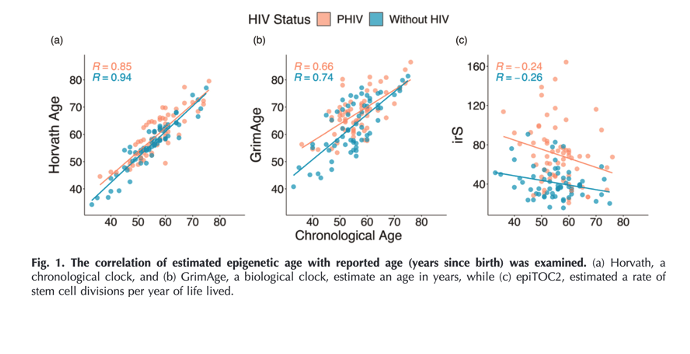| |
Differences in epigenetic age by HIV status
among patients with a non-AIDS defining cancer
|
| |
| |
Download the PDF
nov 1 2023
Dickey, Brittney L.a; Putney, Ryan M.c; Suneja, Gitad; Kresovich, Jacob K.a,e; Spivak, Adam M.f; Patel, Ami B.g; Teng, Mingxiangh; Extermann, Martinei; Giuliano, Anna R.a,b; Gillis, Nancya; Berglund, Andersh; Coghill, Anna E.a,b,j
Abstract
Objective:
People with HIV (PWH) are living longer and experiencing higher numbers of non-AIDS-defining cancers (NADC). Epigenetic aging biomarkers have been linked to cancer risk, and cancer is now a leading cause of death in PWH, but these biomarkers have not been investigated in PWH and cancer.
Design:
In order to compare epigenetic age by HIV status, HIV-uninfected participants were matched to PWH by reported age, tumor site, tumor sequence number, and cancer treatment status.
Methods:
DNA from blood was assayed using Illumina MethylationEPIC BeadChip, and we estimated immune cell composition and aging from three epigenetic clocks: Horvath, GrimAge, and epiTOC2. Age acceleration by clock was computed as the residual from the expected value, calculated using linear regression, for each study participant. Comparisons across HIV status used the Wilcoxon rank sum test. Hazard ratios and 95% confidence intervals for the association between age acceleration and survival in PWH were estimated with Cox regression.
Results:
Among 65 NADC participants with HIV and 64 without, biological age from epiTOC2 (P < 0.0001) and GrimAge (P = 0.017) was significantly higher in PWH. Biological age acceleration was significantly higher in PWH using epiTOC2 (P < 0.01) and GrimAge (P < 0.0001), with the difference in GrimAge remaining statistically significant after adjustment for immune cell composition. Among PWH, GrimAge acceleration was significantly associated with increased risk of death (hazard ratio 1.11; 95% confidence interval (CI) 1.04-1.18).
Conclusion:
We observed a higher epigenetic age in PWH with a NADC diagnosis compared with their HIV-uninfected counterparts, as well as a significant association between this accelerated biological aging and survival for patients diagnosed with a NADC.

|
|
| |
| |
|
|
|